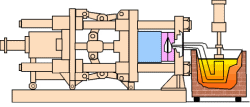Introduction:
Zinc die casting has become a preferred manufacturing technique for a wide range of industries due to its ability to produce complex parts with high precision and efficiency. At the heart of this process lies the importance of reliable and well-designed zinc die casting tooling. With the advancements in technology and materials, manufacturers can now benefit from tooling solutions that elevate the performance and quality of their products. In this article, we will delve into the key aspects of zinc die casting tooling and explore its significance in the manufacturing landscape. Zinc Die Casting Tooling: Enhancing Precision and Efficiency in Manufacturing
1. Precision engineering for flawless production:
Zinc die casting tooling plays a crucial role in ensuring the accuracy and quality of the final product. Precision engineering is at the core of successful tooling design, enabling the production of intricate parts with tight tolerances. A well-crafted tooling design ensures that each casted component conforms to the desired specifications, eliminating defects and variations. This precision not only enhances product performance but also reduces post-processing requirements, resulting in significant cost savings.
2. Maximizing efficiency through optimized tool life:
Efficiency is a top priority in manufacturing, and optimizing tool life is essential in achieving this goal. Zinc die casting tooling is subjected to harsh conditions, including high temperatures and repeated mechanical stress. To maximize tool life, tooling experts employ various techniques such as selecting suitable materials, heat treatment, and surface coatings. These measures enhance the durability of the tooling, reducing downtime for repairs or replacements. By extending tool life, manufacturers can significantly increase their production rates, ultimately leading to higher profitability.
3. Design flexibility for diverse applications:
The versatility of zinc die casting tooling allows manufacturers to cater to a broad range of industries and applications. Whether it’s automotive, electronics, or consumer goods, the tooling can be customized to meet specific requirements. As products become more complex and demand greater design freedom, advanced tooling technologies like computer-aided design (CAD) and simulation software enable manufacturers to quickly prototype and iterate designs. This flexibility enables shorter lead times and faster response to market demands.
4. Continuous innovation driving competitiveness:
To remain competitive in a rapidly evolving industry, manufacturers must embrace continuous innovation in zinc die casting tooling. Advancements in materials, such as high-performance steels and ceramic coatings, offer enhanced tooling capabilities that were once considered impossible. Additionally, cutting-edge technologies like additive manufacturing (3D printing) are revolutionizing tooling design and production processes. Staying abreast of these innovations is crucial for manufacturers to gain a competitive edge and deliver top-quality products to their customers.
Conclusion:
Zinc die casting tooling is a critical component in the manufacturing process, impacting precision, efficiency, and competitiveness. As the demand for high-quality and intricately designed products continues to rise, the importance of well-engineered tooling solutions becomes increasingly evident. Manufacturers must invest in optimizing their tooling processes and embracing technological advancements to unlock the full potential of zinc die casting. By doing so, they can achieve superior performance, reduce costs, and meet the ever-growing expectations of their customers in today’s dynamic marketplace.
Zinc Die Casting Company makes metal parts for several industries. To get metal parts prices or prices for zinc die castings, or Email us at Sales@DieCastingZinc.com for die casting part prices or Zinc Die Casting Tooling Prices.


